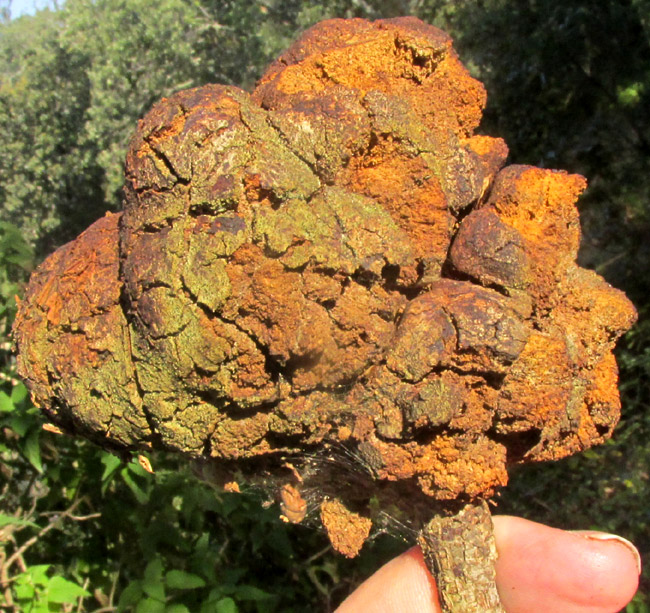Excerpts from Jim Conrad's
Naturalist Newsletter
Entry dated November 9, 2023, from notes taken near Cascadas de La Piedad waterfall 3kms NW of the community of San Pablo, municipality of Almeaco de Bonfil; oak forest atop bedrock of thick layers of compacted volcanic ash, or tuff; N20.1024°, W100.0019°, elevation 2360 meters (7750ft); extreme southern Querétaro state, MÉXICO
OAK STEM GALL ON QUERCUS OBTUSATA

Atop a ridge covered with a somewhat open oak forest, the above gall attached to an oak stem had fallen onto the ground. It's an old one, deteriorating. Here's what it looked like broken apart:

On an Ohio State University webpage profiling a similar but different gall occurring on oak stems in Ohio, in the US, a picture of a broken-open gall shows a stem passing through the gall's center, which was the case with our gall. In the Ohio gall's center, an enlarged area of oak stem "disorganized vascular tissue" was visible; possibly in the above picture, the dark, more compact-looking zone in our gall is such disorganized stem tissue.

Several such galls had fallen beneath the bigoak. The gall pictured above lay beside leaves from that oak, identifying the tree as Quercus obtusata.
The above-mentioned Ohio State page identified the cause of such galls as a gall-wasp species of the Gall Wasp Family, the Cynipidae. Wasps induce the galls by laying eggs on the stems. When the eggs hatch, they eat the gall tissue which has grown to surround them.
On the GBIF Occurrences page for the Cyipidae, which occur nearly worldwide, numerous gall wasp species were documented for our part of highland central Mexico. After comparing our galls with many images of galls observed in our area, caused by members of the Cynipidae, it became clear that the vast majority of Cynipidae galls are smooth and occur on leaves, not stems. However, species of the genus Andricus produced galls some of which became hard and semi-woody like ours.
On the GBIF Occurrences page for the genus Andricus, several species were documented for our highland central Mexican region. Of those species, Andricus quercuslaurinus was mentioned, and on oak trees it produced galls looking like ours. The process is much more complicated by that, nicely described on Wikipedia's Gall Wasp page.
The 2019 study by Karina Ortega-Rivera and others entitled "Caracterización del estado fitosanitario de Quercus obtusata Bonpl., en bosque mesófilo de montaña, Xicotepec, Puebla," singles out our Quercus obtusata as exhibiting a high degree of vulnerability and threat -- "... alto grado de vulnerabilidad y amenaza" -- to the genus Andricus in their study area in Puebla state. Also, they mention "fateful effects of galls in oak forests" .."fatídicos efectos de las agallas en encinares," produced by our suspected Andricus quercuslaurinus. Sometimes trees host large numbers of such galls.
The problem caused byAndricus quercuslaurinus galls is that stem tissue is weakened and killed, so that stem tips later die and break away, as had happened beneath our oak.